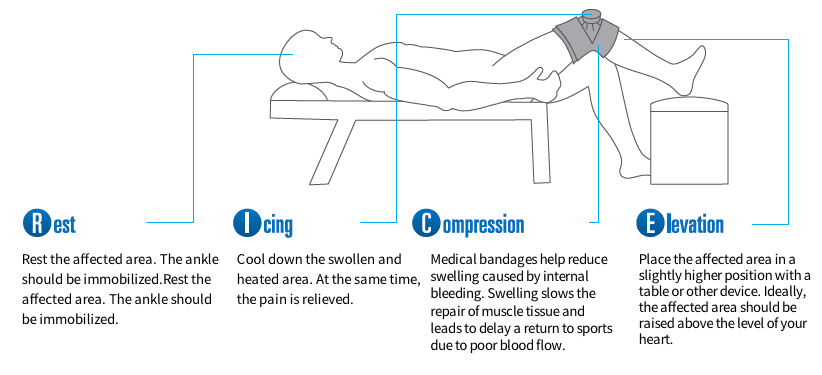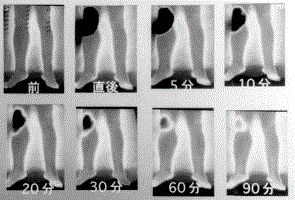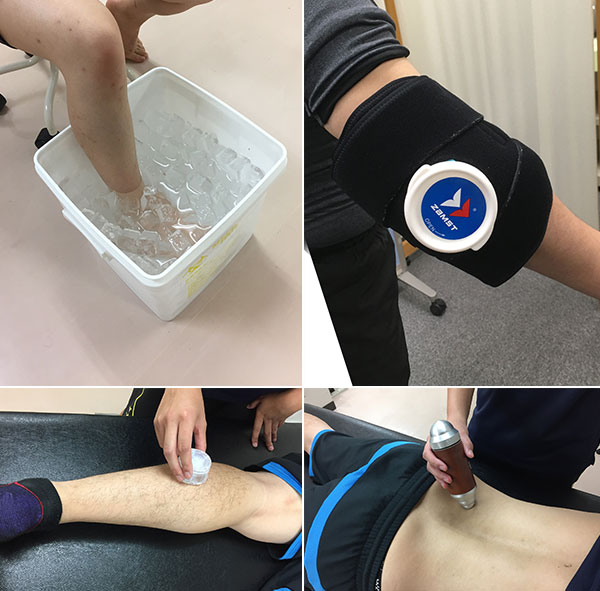Icing


Mitsutoshi Hayashi
Mitsutoshi Hayashi
Doctor of Medicine, specialist in the Japanese Society of Rehabilitation Medicine, specialist in the Japanese Society of Orthopaedic Surgery, specialist in the Japanese Society of Rheumatology, staff to strengthen JOC, and sports physician certified by the Japan Sports Association
Icing
The intense contact in American football play may be one of the real excitements for the audience, but the impact on the player's body is immense. Routine body care, including icing, is essential.
In recent years, icing after sports has become common among Japanese top sports athletes, American football, baseball, and other sports. However, among junior and senior high school students, only for the first aid is used when they get injured in common. On the other hand, in the United States, not only icing after training but also pre-training icing are becoming more common at the level of high school students.
I experienced the practice of icing in the United States 10 years ago, when I was given the opportunity to train as a doctor. I got chance to enter the bench of official matches of the San Diego Padres, an MLB team in San Diego, California, and the San Diego Chargers, an NFL team.
When the pitcher enters the stadium, the first icing is applied. After stretching, the pitcher applies icing again, and after running and pitching practice as well. After pitching, the pitcher applies icing the elbow and the whole shoulder joints covered with finely crushed ice wrapped with a bath towel for 15 to 20 minutes. It is impressive that each sports facility is equipped with a giant ice-making machine for icing care.
Effect of icing
(1) Decreases the temperature of the affected area (mainly on the skin surface).
(2) Decreases cellular metabolism. Icing is also used for first aid for injuries, because cooling reduces blood flow and tissue metabolism, thereby preventing secondary hypoxia in damaged tissues.
(3) Reduces inflammation (suppression of swelling).
(4) Relieves pain (slows nerve transmission apeed).
(5) Effects on blood circulation.
(6) Has relaxation effect in relieving muscle tension.
(7) Be medically used in the beginning of rehabilitation, and effects such as shortening of the treatment period and relief of postoperative pain (depression) are expected.
RICE (S) Procedures: Icing in First Aid of Acute Trauma.
This is the most typical procedure that takes advantage of the effects of rest (=R), icing (=I), compression (=C), elevation (=E), and icing (Stabilization) in acute trauma.

Icing for warp-up exercise
Icing provides an analgesic effect (an increase in the pain threshold) on muscle and joint pain, so players can start to move without any pain during a warm-up. The purpose of this program is to reduce muscle tension by reducing the activity of muscle spindles, which are sensory receptors in skeletal muscle, and to increase the range of motion associated with this reduction.
A thermographic temperature survey of the skin (Photo 1) showed a difference of 10°C or more between 20 minutes after icing and before icing. Warm-ups starting within a period of prolonged cooling effect to allow more effective start-ups with pain relief and to move smoothly into the active phase.

Photo; Changes of skin temperature in thermography after icing immediately
Attention of icing
Icing reduces the activity of local nerves and muscles, so exercise such as a dash should be avoided, but only moderate exercise, such as stretching (a combination of cooling and stretching) is recommended. Patient who has focal hypoesthesia, such as in diabetes mellitus or alcoholic peripheral neuritis, rheumatism, Raynaud's disease (cooling and whitening of the fingertips), focal vascular circulatory disturbances, or hypersensitivity to cooling tends to be frostbitten.
Even a person who does not have the above-mentioned disorders may develop frostbite if cooled for a long time. If there is no sensation in the cooled area, suspend icing and resume the operation after the temperature and sensation of the skin return.
Switching from icing to heating
The criteria for switching from icing to heating therapy includes: (1) no local warmth; (2) no local swelling; (3) no local redness; (4) local congestion and redness; (5) halving of the effect of icing (6) a case that an athlete prefer heating rather than icing; and (7) a chronic phase after an acute traumatic phase.
Seasonal changes
In summer, exercising outdoors makes you get icing effect easier because the overused muscles tend to raise body temperature. In winter, on the other hand, because the temperature is low, let athletes move to indoors quickly after exercising, and stretching or icing in a warm place.
Example of icing at the top team level
Icing at the top team level, which I was responsible for, is applied for 15-20 minutes, mainly ice bags are applied to 4 parts that are (1) the knee (2) shoulder (3) foot and (4) elbow which has pain and warmth. The average is 1.5 parts per person. In some cases, it is used at several different locations at the same time. Comparison between post-exercise and pre-exercise showed that all 12 registered athletes (100%) had put ice on the parts after exercise, and 4 of 12 (33.3%) had icing therapy before exercise as a warm-ups.
I also heard that a circulating ice system while sleeping was found to be useful in 2 players (16.7%) who had knee pain and ankle sprains.
Icing for each body part

Those are the examples of icing for each body part. In addition to ice bags, ice massagers and ice buckets can be used for icing. Please see Trainer Edition for details.

Hitoshi Takahashi
Hitoshi Takahashi
Associate Professor, the Department of Regional Medicine, Teikyo Heisei University
A certified athletic trainer from the Japan Sport Association, a practitioner of acupuncture and a massage practitioner
Osgood's disease (Osgood-Schlatter's disease) (trainer edited)
Methods of icing
This section introduces how athletic trainers and athletes apply icing by themselves. Commercial goods used for icing can be replaced by familiar ones, and this section presents how to make and how to use them.
Ice pack (with coolant)
Storage: Please store in a refrigerator or freezer. Ice packs witch never harden in the freezer are recommended to use.
Fixation: Please fix ice packs with an elastic bandage or ice wrap, and be careful not to get frostbite. If frost is attached on the surface, or if the temperature of refrigerant is not higher than 0°C due to the storage for a long time, put the ice packs outside of the freezer for a while. It is recommended that athletes should apply elastic bandage under the icing body parts, not applying icing packs directly to the skin.
Ice pack (with ice cubes)
How to make: A plastic bag is filled with ice. For use at the waist, large sized plastic bags for plastic buckets are useful. Please choose appropriate size of the plastic bag according to the body parts.
Put ice in about half of the plastic bag. It is important to release the air from the bag as much as possible. (Photo1) Them, the surface of the bag flattens, and ice could cover the wide area of the affected part.
Fixation: An ice wrap or elastic bandage is used for fixation, and an underwrap is also used for fixation (Photo 3).

Photo 1: Releasing air

Photo 2: Fixation with ice wrap, elastic bandage, underwrap
Ice bucket
Use: Please use a bucket of ice water (Photo 3). Using buckets is suitable the parts such as foot, hand and elbow parts. If the size of the ice water container is large, the lower limbs and the whole body could also be iced.

Recommended for 3-joint, foot, hand, and elbow, icing.
Ice massager
Use: Please remove the cap, put ice in, and shake the clicker when you use. Usage is the same as for ice cups. The ice cup may melt and allow water to flow out, but the clicker does not allow water to flow out. Especially the ice massager is recommended to care for lumber parts (Photo). If the ice massager does not move smoothly, an anti-inflammatory analgesic ointment may be used as a lubricant.

Ice bag
Preparation: Please use ice made bu an ice-making machine. Block ice sold in stores had better to be broken into small pieces before placing into the bag. The bag can be inflated by blowing, and ice can be placed smoothly. When ice is put in, the bag is pressed from the top and flattened. At the same time, the air is removed (Photo 5).
Fixation: The cap is tightly closed by turning the cap and bag parts in opposite directions, which will make it easier to handle. Elastic bandages are often used to secure ice packs to the injured area because the bag is often displaced in case of fixing by ice wrap alone . The cap had better to be put on outside of the part to drain the dissolved water (Photo 6).
It is also recommended to use a set of supports for fixation and ice bags which are available on the market and do not require easy wrapping of elastic bandages.

Photo 5: Air is released while putting the ice bag flattened

Photo 6: Please keep the icing bag’s cap uncovered with tapes.
Products in the Zamst icing category are here.
Ice cup (ice massage)
Preparation: Use a paper cup or special cup to make ice and apply it to the part to be iced.
Use: For muscles, move along the course of the muscles, and for joints and ligaments, move around the affected area thoroughly (Photo 7).

Photo 7: How to carry it varies depending on the area and the parts to be iced.
Notice
There are the points to remember when performing icing. Please pay attention to the body’s response to cold stimulus during icing.
1. Case of hypersensitivity
Icing should not be used if the patient is hypersensitive to a cold stimulus. Hypersensitivity is a condition in which the skin becomes blue-purple (cyanosis) due to cold urticaria or decreased blood flow.
2. Frostbite
It should be aware when frost is attended on the surface of the ice or cooling material. In such cases, the sample should be left at room temperature for a while (after the surface has been released) before use. Frostbite may also occur if the icing period is too long.
3. Decreased body temperature
Icing covering wide area or long period may cause body temperature lower. Please be aware especially in situations where body temperature is likely to be decreased, such as in winter or in rainy weather.

